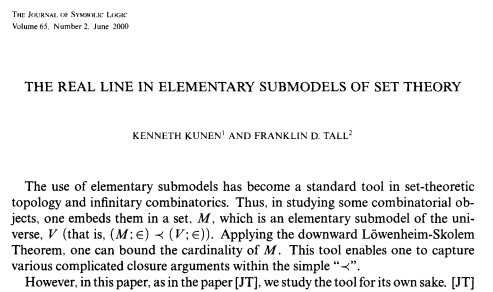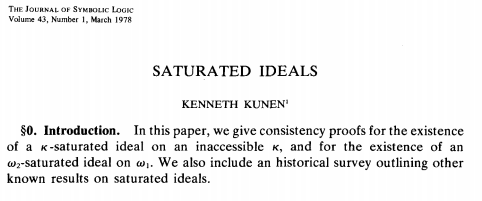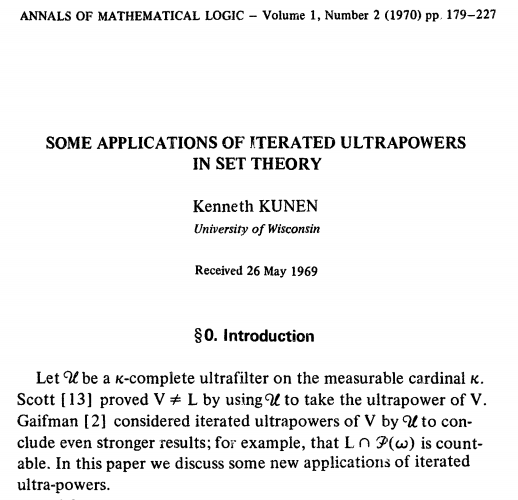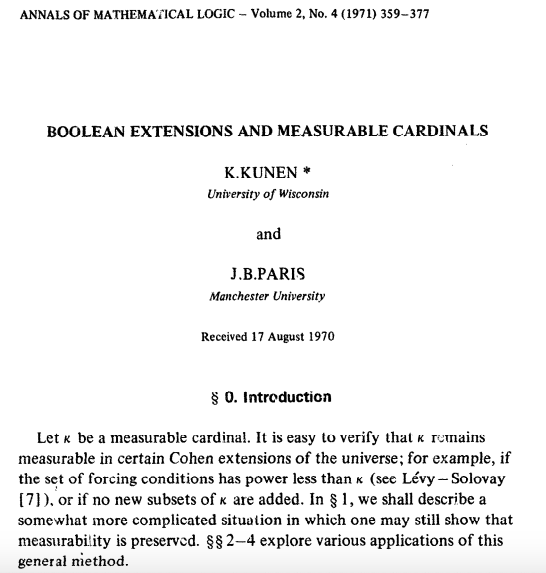Kenneth Kunen, a thread.
"The real line in elementary submodels of set theory" appeared in The Journal of Symbolic Logic 65 (2000), no. 2, 683–691. https://doi.org/10.2307/2586561
This fun paper was written by Ken and Frank Tall. It appeared while I was in grad school.
1/
"The real line in elementary submodels of set theory" appeared in The Journal of Symbolic Logic 65 (2000), no. 2, 683–691. https://doi.org/10.2307/2586561
This fun paper was written by Ken and Frank Tall. It appeared while I was in grad school.
1/
I remember it because of the title of the first draft Ken posted on his page: "What I did this summer."
I only interacted with him very briefly, but his good humor was always apparent.
2/
I only interacted with him very briefly, but his good humor was always apparent.
2/
I believe the first time I contacted him was while working on my thesis. I was interested in the consistency of the existence of definable well-orderings of the reals under various hypotheses, in particular, the existence of a real-valued measurable cardinal.
3/
3/
This sort of thing is obtained by starting with, say, a measurable k, and coding a well-ordering by iterated forcing while adding random reals. If done carefully, the real-valued measurability of k is preserved.
4/
4/
But as variant of the forcing provided a natural example of a sequence V⊆M⊆W where k is measurable in V and in W, but not in M. (You add a stationary non-reflecting set, but the final forcing destroys its stationarity.)
Kunen was the first to prove this.
5/
Kunen was the first to prove this.
5/
His elegant proof was different from mine. It appeared in a famous paper of his.
"Saturated ideals", J. Symbolic Logic 43 (1978), no. 1, 65–76. https://doi.org/10.2307/2271949
6/
"Saturated ideals", J. Symbolic Logic 43 (1978), no. 1, 65–76. https://doi.org/10.2307/2271949
6/
In both his argument and mine, the measurable k is not even weakly compact in the intermediate model. I think it was open for a while whether one could preserve weak compactness and then resurrect measurability. Something completely different would be needed.
7/
7/
I mentioned this to Joel Hamkins ( @JDHamkins) once, and he immediately saw how to do it.
Oh, well.
8/
Oh, well.

8/
Ken's work in set theory is fundamental in inner model theory. He found some of the fundamental ideas in the field in his study of L[μ]. I would definitely not call myself an inner model theorist, although I've published a few things that use results in the area.
9/
9/
His paper on this topic is "Some applications of iterated ultrapowers in set theory", Ann. Math. Logic 1 (1970), 179–227. https://doi.org/10.1016/0003-4843(70)90013-6
10/
10/
Here, Ken introduces the comparison argument, that shows that if one has two models L[𝒰] and L[μ], both of which look like the smallest inner model of "there is a measurable cardinal", then one is an iterated ultrapower of the other and,
11/
11/
if they agree on which cardinal is measurable, then they also agree on the witnessing measure. The key idea is surprisingly simple: if there is a disagreement, iterate it way, and it "eventually disappears".
12/
12/
This simple idea persists even for cardinal notions much stronger than measurability, and even in settings where the comparison process is much more involved than the linear iterations needed here.
13/
13/
I first learned of Kunen through his textbook, of course. Nowadays I find some of it idiosyncratic (his use of R(k) for what everyone else calls Vk, or his notation for Cohen forcing or for the Lévy collapse), but as an introduction, it is excellent.
14/
14/
His chapter on infinitary combinatorics is full of beautiful arguments. And some of the exercises are real gems.
https://mathoverflow.net/q/40507/6085
15/
https://mathoverflow.net/q/40507/6085
15/
"Set theory. An introduction to independence proofs". Studies in Logic and the Foundations of Mathematics, 102. North-Holland Publishing Co., Amsterdam-New York, 1980. xvi+313 pp. ISBN: 0-444-85401-0.
https://www.elsevier.com/books/set-theory-an-introduction-to-independence-proofs/kunen/978-0-444-86839-8
16/
https://www.elsevier.com/books/set-theory-an-introduction-to-independence-proofs/kunen/978-0-444-86839-8
16/
One of the requirements for undergrads at the Universidad de los Andes, where I went, is to write a thesis. I knew I wanted something in set theory, but was not sure of the specific topic.
17/
17/
Soon before I had to decide, I met Andrés Villaveces ( @avillavecesn), who was then finishing up his thesis under Ken. Andrés visited Bogotá in the Summer and ran a seminar, where I was first exposed to forcing arguments involving large cardinals. It was beautiful!
18/
18/
We began with the Kunen-Paris paper on the number of normal measures on a measurable cardinal.
Kunen, K.; Paris, J. B. "Boolean extensions and measurable cardinals". Ann. Math. Logic 2 (1970/71), no. 4, 359–377.
https://doi.org/10.1016/0003-4843(71)90001-5
19/
Kunen, K.; Paris, J. B. "Boolean extensions and measurable cardinals". Ann. Math. Logic 2 (1970/71), no. 4, 359–377.
https://doi.org/10.1016/0003-4843(71)90001-5
19/
(I ended up choosing for my thesis to write a survey on the singular cardinals hypothesis.)
20/
20/
The last topic I want to mention is his famous inconsistency result, showing that there are no elementary embeddings from the universe V of all sets into itself.
21/
21/
"Elementary embeddings and infinitary combinatorics". J. Symbolic Logic 36 (1971), 407–413. https://doi.org/10.2307/2269948
22/
22/
Many extensions of this result have been considered since. For instance, Matt Foreman showed that we cannot have an elementary embedding j:M→V if M is closed under countable sequences.
23/
23/
Ken's argument uses choice in an essential way, and so do all other proofs found since (by Matt Foreman, Hugh Woodin, Jindra Zapletal, Menachem Magidor, ...). A lot of effort has been put on seeing whether choice can be removed.
24/
24/
Hugh Woodin has considered this problem and some of his work on ultimate-L attempts to obtain a Kunen-like result in the absence of choice, under additional large cardinal assumptions.
25/
25/
Versions of the inconsistency in ZF have been obtained for definable embeddings.
The combinatorics of Reinhardt cardinals (the critical points of embeddings j:V→V in the absence of choice) are really interesting.
26/
The combinatorics of Reinhardt cardinals (the critical points of embeddings j:V→V in the absence of choice) are really interesting.
26/
For instance, Arthur Apter and Grigor Sargsyan obtained very strong infinite exponent partition relations from this assumption.
29/
29/
(27/ Oops.)
I've also looked at extensions of the inconsistency result in my own work. I became interested in this after obtaining some results relating the structure of V and an inner model W, from the assumption that V and W agree on some cardinals.
28/
I've also looked at extensions of the inconsistency result in my own work. I became interested in this after obtaining some results relating the structure of V and an inner model W, from the assumption that V and W agree on some cardinals.
28/
After such results, it seemed natural to me to study whether there can be elementary embeddings j:V→M or j:M→V under the assumption that M computes cardinals correctly.
29/
29/
The paper is "Cardinal preserving elementary embeddings". In Logic Colloquium 2007, F. Delon, U. Kohlenbach, P. Maddy, F. Stephan, eds., Lecture Notes in Logic, Cambridge University Press – ASL (2010), 14–31. https://doi.org/10.1017/CBO9780511778421.004
https://andrescaicedo.files.wordpress.com/2010/04/cardinalpreserving.pdf
30/
https://andrescaicedo.files.wordpress.com/2010/04/cardinalpreserving.pdf
30/
The problem remains open (in both versions). I showed that, for instance, the proper forcing axiom PFA precludes the existence of such embeddings j:M→V.
Any embedding j:V→M with M and V having the same cardinals must be highly discontinuous, that is,
31/
Any embedding j:V→M with M and V having the same cardinals must be highly discontinuous, that is,
31/
there are many cardinals k such that j(k) is larger than the supremum of the ordinals j(a), for a<k. This implies that there are many large cardinals that carry some amount of strong compactness.
Very recently, Gabe Goldberg extended this idea, by showing that,
32/
Very recently, Gabe Goldberg extended this idea, by showing that,
32/
if we assume that there is a proper class of strongly compact cardinals, then there is no such embedding. You can find this at "Some combinatorial properties of Ultimate L and V", https://arxiv.org/abs/2007.04812
33/
33/
For many of us, the news of Ken's passing has been somewhat of a shock. I wanted to help remember him by celebrating some of the intersections I've had with his work.
34/34
34/34

 Read on Twitter
Read on Twitter






